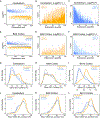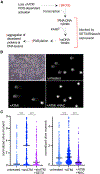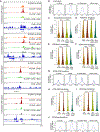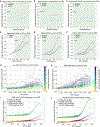Regulation of transcription patterns, poly(ADP-ribose), and RNA-DNA hybrids by the ATM protein kinase
- PMID: 38442018
- PMCID: PMC11022685
- DOI: 10.1016/j.celrep.2024.113896
Regulation of transcription patterns, poly(ADP-ribose), and RNA-DNA hybrids by the ATM protein kinase
Abstract
The ataxia telangiectasia mutated (ATM) protein kinase is a master regulator of the DNA damage response and also an important sensor of oxidative stress. Analysis of gene expression in ataxia-telangiectasia (A-T) patient brain tissue shows that large-scale transcriptional changes occur in patient cerebellum that correlate with the expression level and guanine-cytosine (GC) content of transcribed genes. In human neuron-like cells in culture, we map locations of poly(ADP-ribose) and RNA-DNA hybrid accumulation genome-wide with ATM inhibition and find that these marks also coincide with high transcription levels, active transcription histone marks, and high GC content. Antioxidant treatment reverses the accumulation of R-loops in transcribed regions, consistent with the central role of reactive oxygen species in promoting these lesions. Based on these results, we postulate that transcription-associated lesions accumulate in ATM-deficient cells and that the single-strand breaks and PARylation at these sites ultimately generate changes in transcription that compromise cerebellum function and lead to neurodegeneration over time in A-T patients.
Keywords: ATM; CP: Molecular biology; DNA repair; R-loops; cerebellar ataxia; poly-ADP-ribosylation; transcription.
Copyright © 2024 The Authors. Published by Elsevier Inc. All rights reserved.
Conflict of interest statement
Declaration of interests The authors declare no competing interests.
Figures






Update of
-
Regulation of transcription patterns, poly-ADP-ribose, and RNA-DNA hybrids by the ATM protein kinase.bioRxiv [Preprint]. 2023 Dec 7:2023.12.06.570417. doi: 10.1101/2023.12.06.570417. bioRxiv. 2023. Update in: Cell Rep. 2024 Mar 26;43(3):113896. doi: 10.1016/j.celrep.2024.113896. PMID: 38106035 Free PMC article. Updated. Preprint.
References
-
- Barzilai A, Rotman G, and Shiloh Y (2002). ATM deficiency and oxidative stress: a new dimension of defective response to DNA damage. DNA Repair 1, 3–25. - PubMed
MeSH terms
Substances
Grants and funding
LinkOut - more resources
Full Text Sources
Medical
Molecular Biology Databases
Research Materials
Miscellaneous

